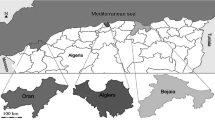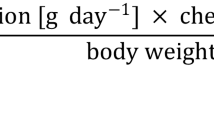Abstract
A total of 127 and 177 seafood samples from Malaysia were analyzed for polychlorinated dibenzo-p-dioxins/dibenzofurans (PCDD/Fs) and dioxin-like polychlorinated biphenyls (dl-PCBs), respectively. The World Health Organization-toxic-equivalency quotients (WHO-TEQ) of PCDD/Fs varied from 0.13 to 1.03 pg TEQ g−1, whereas dl-PCBs ranged from 0.33 to 1.32 pg TEQ g−1. Based on food-consumption data from the global environment monitoring system—food contamination monitoring and assessment programme, calculated dietary exposures to PCDD/Fs and dl-PCBs from seafood for the general population in Malaysia were 0.042 and 0.098 pg TEQ kg−1 body weight day−1, respectively. These estimations were quite different from the values calculated using the Malaysian food-consumption statistics (average of 0.313 and 0.676 pg TEQ kg−1 body weight day−1 for PCDD/Fs and PCBs, respectively). However, both of the dietary exposure estimations were lower than the tolerable daily intake recommended by WHO. Thus, it is suggested that seafood from Malaysia does not pose a notable risk to the health of the average consumer.


Similar content being viewed by others
References
ATSDR (Agency for Toxic Substances and Disease Registry) (2014) Polychlorinated Biphenyls (PCBs). http://www.atsdr.cdc.gov/substances/toxsubstance.asp?toxid=26. Accessed 19 March 2014
Becker W, Darnerud PO, Petersson-Grawe K (2007) Risks and benefits of fish consumption. A risk-benefit analysis based on the occurrence of dioxin/PCB, methyl mercury, n-3 fatty acids and vitamin D in fish. National Food Administration Report Series No. 12/2007. FDA, Silver Spring
Bocio A, Domingo JL, Falco G, Llobet JM (2007) Concentrations of PCDD/PCDFs and PCBs in fish and seafood from the Catalan (Spain) market: estimated human intake. Environ Int 33:170–175
Consonni D, Sindaco R, Bertazzi PA (2012) Blood levels of dioxins, furans, dioxin-like PCBs, and TEQs in general populations: a review, 1989–2010. Environ Int 44:151–162
Darnerud PO, Atuma S, Aune M, Bjerselius R, Glynn A, Becker W, Grawe′ KP (2006) Dietary intake estimations of organohalogen contaminants (dioxins, PCB, PBDE and chlorinated pesticides, e.g., DDT) based on Swedish market basket data. Food Chem Toxicol 44:1597–1606
Dorne JLCM, Bordajandi LR, Amzal B, Ferrari P, Verger P (2009) Combining analytical techniques, exposure assessment and biological effects for risk assessment of chemicals in food. Trends Anal Chem 28:695–707
EFSA (2005) Opinion of the Scientific Panel on Contaminants in the Food Chain on a request from the commission related to the presence on nondioxin-like polychlorinated biphenyls (PCB) in feed and food (question no. EFSA-Q-2003-114). http://pcbinschools.org/EFSA%20Journal%202005.pdf. Accessed: 27 January 2014
European Commission (2006) Commission regulation (EC) no. 1881/2006 of 19 December 2006 setting maximum levels for certain contaminants in foodstuff. Official Journal of the European Union L364/5. http://eur-lex.europa.eu/LexUriServ/LexUriServ.do?uri=OJ:L:2006:364:0005:0024:EN:PDF. Accessed: 7 June 2013
European Commission (2011) Commission regulation (EU) no. 1259/2011 of 2 December 2011 amending regulation (EC) no. 1881/2006 as regards maximum levels for dioxins, dioxin-like PCBs and non dioxin-like PCBs in foodstuffs. J Eur Union L320/18. http://eurlex.europa.eu/LexUriServ/LexUriServ.do?uri=OJ:L:2011:320:0018:0023:EN:PDF. Accessed: 20 June 2013
European Commission (2013) Recent contamination incidents related to dioxins. http://ec.europa.eu/food/food/chemicalsafety/contaminants/dioxins_en.htm. Accessed: 24 April 2013
European Commission Scientific Committee on Food (2001) Opinion on the risk assessment of dioxins and dioxin-like PCBs in food (22 November 2000). http://ec.europa.eu/food/fs/sc/scf/out78_en.pdf. Accessed: 20 June 2013
Fattore E, Fanelli R, Turrini A, di Domenico A (2006) Current dietary exposure to polychlorodibenzo-p-dioxins, polychlorodibenzofurans, and dioxin-like polychlorobiphenyls in Italy. Mol Nutr Food Res 50:915–921
FEHD (2011) The first Hong Kong total diet study report no. 1: the first Hong Kong total diet study: dioxins and dioxin-like polychlorinated biphenyls (PCBs). http://www.cfs.gov.hk/english/programme/programme_firm/files/Report_on_the_first_HKTDS_dioxin.pdf. Accessed: 24 January 2014
Fernandes A, White S, D’Silva K, Rose M (2004) Simultaneous determination of PCDDs, PCDFs, PCBs and PBDEs in food. Talanta 63:1147–1155
Fernández MA, Gomara B, Bordajandi LR, Herrero L, Abad E, Abalos M et al (2004) Dietary intakes of polychlorinated dibenzo-p-dioxins, dibenzofurans and dioxin-like polychlorinated biphenyls in Spain. Food Addit Contam 21:983–991
GEMS (2013) GEMS/food cluster diets 2012. http://www.who.int/foodsafety/chem/gems/en/index1.html. Accessed: 3 June 2013
Hsu MS, Hsu KY, Wang SM, Chou U, Chen SY, Huang NC et al (2007) A total diet study to estimate PCDD/Fs and dioxin-like PCBs intake from food in Taiwan. Chemosphere 67:S65–S70
IARC (1997) IARC monographs on the evaluation of carcinogenic risks to humans, volume 69. Polychlorinated dibenzo-para-dioxins and polychlorinated dibenzofurans. http://monographs.iarc.fr/ENG/Monographs/vol69/volume69.pdf. Accessed: 19 June 2013
IARC (2012) IARC Monographs on the evaluation of carcinogenic risks to humans, volume 100F. 2,3,7,8-Tetrachlorodibenzo-para-dioxin, 2,3,4,7,8-pentachlorodibenzofuran, and 3,3′,4,4′,5-pentachlorobiphenyl. http://monographs.iarc.fr/ENG/Monographs/vol100F/mono100F-27.pdf. Accessed: 22 January 2014
Jiang Q, Hanari N, Miyake Y, Okazawa T, Lau RKF, Chen K et al (2007) Health risk assessment for polychlorinated biphenyls, polychlorinated dibenzo-p-dioxins and dibenzofurans, and polychlorinated naphthalenes in seafood from Guangzhou and Zhoushan, China. Environ Pollut 148:31–39
Karl H, Ruoff U (2007) Dioxins, dioxin-like PCBs and chloroorganic contaminants in herring, Clupea harengus, from different fishing grounds of the Baltic Sea. Chemosphere 67:S90–S95
Koistinen J, Kiviranta H, Ruokojarvi P, Parmanne R, Verta M, Hallikainen A et al (2008) Organohalogen pollutants in herring from the northern Baltic Sea: concentrations, congener profiles and explanatory factors. Environ Pollut 154(2):172–183
Marin S, Villalba P, Diaz-Ferrero J, Font G, Yusà V (2011) Congener profile, occurrence and estimated dietary intake of dioxins and dioxin-like PCBs in foods marketed in the region of Valencia (Spain). Chemosphere 82:1253–1261
Matthews V, Päpke O, Gaus C (2008) PCDD/Fs and PCBs in seafood species from Moreton Bay, Queensland, Australia. Mar Pollut Bull 57:392–402
Miller A, Hedman JE, Nyberg E, Haglund P, Cousins IT, Wiberg K et al (2013) Temporal trends in dioxins (polychlorinated dibenzo-p-dioxin and dibenzofurans) and dioxin-like polychlorinated biphenyls in Baltic herring (Clupea harengus). Mar Pollut Bull 73:220–230
Ministry of Health Malaysia (2006) Food consumption statistics of Malaysia 2003. For adult population aged 18 to 59 years, vol 1. Ministry of Health Malaysia, Putrajaya
Moon HB, Choi HG (2009) Human exposure to PCDDs, PCDFs and dioxin-like PCBs associated with seafood consumption in Korea from 2005 to 2007. Environ Int 35:279–284
Nakatani T, Yamamoto A, Ogaki S (2011) A survey of dietary intake of polychlorinated dibenzo-p-dioxins, polychlorinated dibenzofurans, and dioxin-like coplanar polychlorinated biphenyls from food during 2000–2002 in Osaka City, Japan. Arch Environ Contam Toxicol 60:543–555
Nasir NNM, Azlan A, Razman MR, Ramli NA, Latiff AA (2011) Dioxins and furans in demersal fish and shellfish from regions in west coast peninsular Malaysia. J Food Agric Environ 9(2):72–78
Norimah AK, Safiah M, Jamal K, Haslinda S, Zuhaida H, Rohida S et al (2008) Food consumption patterns: findings from the Malaysian adult nutrition survey (MANS). Malays J Nutr 14(1):25–39
Ntow WJ (2001) Organochlorine pesticides in water, sediment, crops and human fluids in a farming community in Ghana. Arch Environ Contam Toxicol 40:557–563
Onozuka D, Yoshimura T, Kaneko S, Furue M (2008) Mortality after exposure to polychlorinated biphenyls and polychlorinated dibenzofurans: a 40-year follow-up study of Yusho patients. Am J Epidemiol 169(1):86–95
Parzefall W (2002) Risk assessment of dioxin contamination in human food. Food Chem Toxicol 40(8):1185–1189
Perello G, Gomez-Catalan J, Castell V, Llobet JM, Domingo JL (2012) Assessment of the temporal trend of the dietary exposure to PCDD/Fs and PCBs in Catalonia, Spain: health risks. Food Chem Toxicol 50:399–408
Ruus A, Berge JA, Bergstad OA, Knutsen JA, Hylland K (2006) Disposition of polychlorinated dibenzo-p-dioxins (PCDDs) and polychlorinated dibenzofurans (PCDFs) in two Norwegian epibenthic marine food webs. Chemosphere 62:1856–1868
Safe SH (1986) Comparative toxicology and mechanism of action of polychlorinated dibenzo-p-dioxins and dibenzofurans. Ann Rev Pharmacol 26:371–399
Sasamoto T, Ushio F, Kikutani N, Saitoh Y, Yamaki Y, Hashimoto T et al (2006) Estimation of 1999–2004 dietary daily intake of PCDDs, PCDFs and dioxin-like PCBs by a total diet study in metropolitan Tokyo, Japan. Chemosphere 64:634–641
Srogi K (2008) Levels and congener distributions of PCDDs, PCDFs and dioxin-like PCBs in environmental and human samples: a review. Environ Chem Lett 6:1–28
Ssebugere P, Kiremire BT, Henkelmann B, Bernhöft S, Kasozi GN, Wasswa J et al (2013) PCDD/Fs and dioxin-like PCBs in fish species from Lake Victoria, East Africa. Chemosphere 92:317–321
Storelli MM, Barone G, Perrone VG, Giacominelli-Stuffler R (2011) Polychlorinated biphenyls (PCBs), dioxins and furans (PCDD/Fs): occurrence in fishery products and dietary intake. Food Chem 127:1648–1652
Struciński P, Piskorska-Pliszczyńska J, Maszewski S, Góralczyk K, Warenik-Bany M, Mikołajczyk S et al (2013) PCDD/Fs and DL-PCBs intake from fish caught in Polish fishing grounds in the Baltic Sea—characterizing the risk for consumers. Environ Int 56:32–41
Van den Berg M, Birnbaum L, Bosveld ATC, Brunström B, Cook P, Feeley M et al (1998) Toxic equivalency factors (TEFs) for PCBs, PCDDs, PCDFs for humans and wildlife. Environ Health Perspect 106:775–792
Van den Berg M, Birnbaum L, Denison M, De Vito M, Farland W, Feeley M et al (2006) The 2005 World Health Organization reevaluation of human and mammalian toxic equivalency factors for dioxins and dioxin-like compounds. Toxicol Sci 93(2):223–241
Wang I-C, Wu Y-L, Lin L-F, Chang-Chien G-P (2009) Human dietary exposure to polychlororinated dibenzo-p-dioxins and polychlorinated dibenzofurans in Taiwan. J Hazard Mater 164:621–626
World Health Organization (2000) Assessment of the health risk of dioxins: Reevaluation of the tolerable daily intake (TDI). In: van Leeuwen FXR, Younes MM (eds) Food additives and contaminants. Taylor and Francis, London. http://www.who.int/ipcs/publications/en/exe-sum-final.pdf. Accessed: 21 June 2013
World Health Organization (2002) Polychlorinated dibenzodioxines, polychlorinated dibenzofurans, and coplanar polychlorinated biphenyls. Evaluation of certain food additives and contaminants. In: Fifty-seventh report of the Joint FAO/WHO Expert Committee on Food Additives. WHO Technical Report Series 909. WHO, Geneva. http://whqlibdoc.who.int/trs/WHO_TRS_909.pdf. Accessed: 8 January 2014
World Health Organization (2006) GEMS/Food total diet studies. In: Report of the 4th international workshop on total diet studies. http://www.who.int/foodsafety/publications/chem/TDS_Beijing_2006_en.pdf. Accessed: 21 June 2013
Author information
Authors and Affiliations
Corresponding author
Rights and permissions
About this article
Cite this article
Leong, YH., Gan, CY. & Majid, M.I.A. Dioxin-Like Polychlorinated Biphenyls, Polychlorinated Dibenzo-p-Dioxins, and Polychlorinated Dibenzofurans in Seafood Samples from Malaysia: Estimated Human Intake and Associated Risks. Arch Environ Contam Toxicol 67, 21–28 (2014). https://doi.org/10.1007/s00244-014-0019-5
Received:
Accepted:
Published:
Issue Date:
DOI: https://doi.org/10.1007/s00244-014-0019-5




